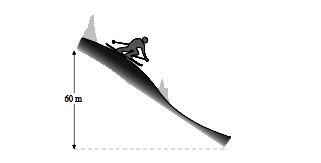A bicyclist is traveling at a speed of 20.0 m/s as the approaches the bottom of a hill. He decides to coast up the hill and stops upon reaching the top. Neglecting friction, determine the vertical height of the hill .
28.5m
11.2m
20.4m
40.8m
The correct Answer is:C
To solve the problem, we will use the principle of conservation of energy, specifically the work-energy theorem. The kinetic energy of the bicyclist at the bottom of the hill will be converted into gravitational potential energy at the top of the hill.
1. Identify the Initial Kinetic Energy (KE_initial):
The initial kinetic energy of the bicyclist can be calculated using the formula:
KEinitial=12mv2
where v=20.0m/s is the speed of the bicyclist.
2. Set the Final Kinetic Energy (KE_final):
At the top of the hill, the bicyclist comes to a stop, so the final kinetic energy is:
KEfinal=0
3. Identify the Change in Potential Energy (PE):
The potential energy at the height h is given by:
PE=mgh
where g=9.8m/s2 is the acceleration due to gravity.
4. Apply the Work-Energy Principle:
According to the work-energy principle, the work done on the bicyclist is equal to the change in kinetic energy:
KEfinal−KEinitial=−PE
Since KEfinal=0 and KEinitial=12mv2, we have:
0−12mv2=−mgh
5. Rearranging the Equation:
Rearranging the equation gives:
mgh=12mv2
We can cancel m from both sides (assuming m≠0):
gh=12v2
6. Solve for Height (h):
Rearranging for h:
h=v22g
Substituting v=20.0m/s and g=9.8m/s2:
h=(20.0)22×9.8
h=40019.6≈20.41m
Final Answer:
The vertical height of the hill is approximately 20.41m.
---
The initial kinetic energy of the bicyclist can be calculated using the formula:
KEinitial=12mv2
where v=20.0m/s is the speed of the bicyclist.
At the top of the hill, the bicyclist comes to a stop, so the final kinetic energy is:
KEfinal=0
The potential energy at the height h is given by:
PE=mgh
where g=9.8m/s2 is the acceleration due to gravity.
According to the work-energy principle, the work done on the bicyclist is equal to the change in kinetic energy:
KEfinal−KEinitial=−PE
Since KEfinal=0 and KEinitial=12mv2, we have:
0−12mv2=−mgh
Rearranging the equation gives:
mgh=12mv2
We can cancel m from both sides (assuming m≠0):
gh=12v2
Rearranging for h:
h=v22g
Substituting v=20.0m/s and g=9.8m/s2:
h=(20.0)22×9.8
h=40019.6≈20.41m
The vertical height of the hill is approximately 20.41m.
Topper's Solved these Questions
- WORK, POWER, AND ENERGYBOOK - RESNICK AND HALLIDAYCHAPTER - WORK, POWER, AND ENERGYEXERCISE - PRACTICE QUESTIONS (More than one choice correct type)
10 Videos
- WORK, POWER, AND ENERGYBOOK - RESNICK AND HALLIDAYCHAPTER - WORK, POWER, AND ENERGYEXERCISE - PRACTICE QUESTIONS (Linked Comprehension)
9 Videos
- WORK, POWER, AND ENERGYBOOK - RESNICK AND HALLIDAYCHAPTER - WORK, POWER, AND ENERGYEXERCISE - PROBLEMS
58 Videos
- WAVES-IBOOK - RESNICK AND HALLIDAYCHAPTER - WAVES-IEXERCISE - Practice Questions (Integer Type)
4 Videos
Similar Questions
Knowledge Check
A skier leaves the top of a slope with an initial speed of 5.0 m/s. Her speed at the bottom of the slope is 13 m/s. What is the height of the slope ?
A1.1mB4.6mC6.4mD7.3mFrom the top of a cliff 90 m high, the angles of depression of the top and bottom of a tower are observed to be 30∘ and 60∘ respectively. The height of the tower is :
A60 mB75 mC30 mD45 mA house is built on the top of a hill with 45∘slope Due to the sliding of meterial and sand top from top to the bottom of till , the slip angle has been redaced if the coefficient of static friction between sand particles is 0.75 what is the final angle attated by bill ? (tan−10.75=37∘)
 A8∘B45∘C37∘D30∘
A8∘B45∘C37∘D30∘
A bicyclist of mass 80 kg (including the bicycle) can coast down a 3.4∘ hill at a steady speed of 6 kph Pumping hard, the cyclist can descend the hill at a speed of 30 kph Using the same power, at what speed cant he cyslist climb the same hill ? Assume the force of friction is directly proportional to the speed v.
View SolutionA man standing on the deck of a ship, which is 10m above water level. He observes the angle of elevation of the top of a hill as 600 and the angle of depression of the base of the hill as 300. Calculate the distance of the hill from the ship and the height of the hill.
View SolutionA man standing on the deck of a ship, which is 8m above water level. He observes the angle of elevation of the top of a hill as 60o and the angle of depression of the base of the hill as 30o . Calculate the distance of the hill from the ship and the height of the hill.
View SolutionA car weighing 1400 kg is moving at speed of 54 km/h up a hill when the motor stops. If it is just able to read the destination which is at a height of 10 m above the point calculte the work done against friction (negative of the work done by the friction).
View SolutionA man is standing on the deck of a ship, which is 8m above water level. He observes the angle of elevation of the top of a hill as 60∘ and the angle of depression of the base of the hill as 30∘. Calculate the distance of the hill from the ship and the height of the hill
View Solution

